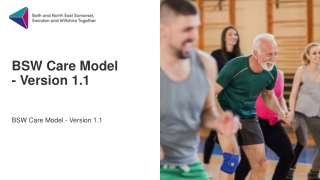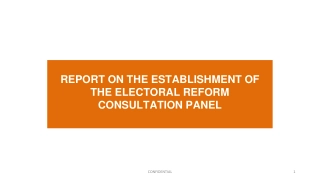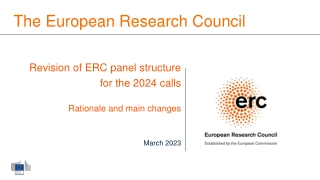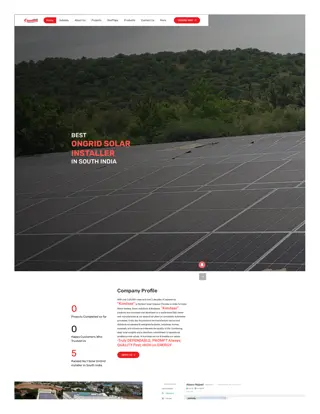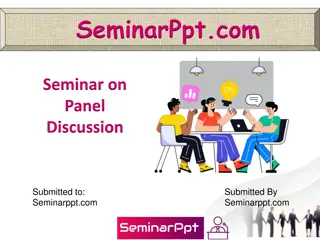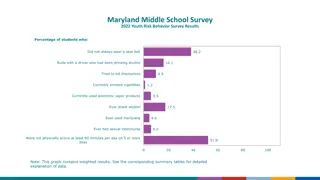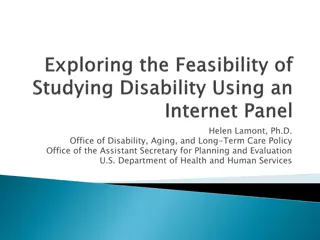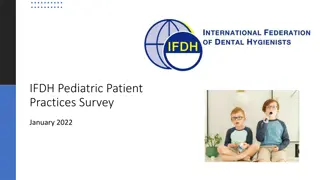
Survey Results: Shaping a Healthier Future in BSW Region
"Discover the insights gathered from the Our Health Our Future panel survey conducted to shape a healthier future in Bath and North East Somerset, Swindon, and Wiltshire. Explore response rates, participant profiles, and key findings."
Download Presentation

Please find below an Image/Link to download the presentation.
The content on the website is provided AS IS for your information and personal use only. It may not be sold, licensed, or shared on other websites without obtaining consent from the author. If you encounter any issues during the download, it is possible that the publisher has removed the file from their server.
You are allowed to download the files provided on this website for personal or commercial use, subject to the condition that they are used lawfully. All files are the property of their respective owners.
The content on the website is provided AS IS for your information and personal use only. It may not be sold, licensed, or shared on other websites without obtaining consent from the author.
E N D
Presentation Transcript
Our Health Our Future Panel Survey 7 results A survey on shaping a healthier future for the BSW region Survey conducted 4thNovember to 3rdJanuary 2022
Report structure 1. Introduction Page 2 2. Overview summary Page 6 3a. Survey 7 results Keeping well Page 10 3b. Survey 7 results Health and care model Page 13 4. Appendices Panel profile Page 33 1
Section 1 Introduction 2
Section 1 - Introduction Vision and mission of the Our Health Our Future Panel The Our Health, Our Future (OHOF) Panel is a way for us to engage with those living in Bath and North East Somerset, Swindon and Wiltshire (BSW) to get their views on health and care issues. In line with our value of "inclusive", the online panel is made up of a representative sample of the population from across our region. Panel members will take part in regular surveys throughout the year. Panel surveys will inform both strategic direction and day-to-day service delivery, particularly around proposed service change or development of new services. Anonymised feedback will be shared with project managers and senior leaders to help shape and influence partnership initiatives and programmes of work. Anonymised feedback will also be made publicly available so panel members and the wider public will have the opportunity to review the results 3
Section 1 - Introduction Response rates remain strong A 44% response rate is considerably higher than the average response rate for similar panels. Approximately 40% remains the target response rate for OHOF Survey 1 (Jan to March 2020) Survey 2 (May 2020) Survey 3 (Jul/Aug 2020) Survey 4 (Nov/Dec 2020) Survey 5 (March/Apr 2021) Survey 6 (Jul/Aug 2021) Survey 7 (Nov 21 to Jan 22 Number of participants 790 381 382 501 395 381 521 Response rate 100% 48% 45% 50% 40% 38% 44% All conducted via via face to face recruitment interviews Including 170 face to face recruitment interviews Conducted online/ postal/ telephone only Conducted online/ postal/ telephone only Including 200 face to face recruitment interviews Conducted online/ postal/ telephone only Conducted online/ postal/ telephone only Method 4
Section 1 Introduction We have a robust and representative panel % of BSW entire population/survey 7 participant rim weighted profile (521) % of our actual panellist profile as at Dec 2021 (1,187) 22% BaNES 22% 27% Swindon 26% 51% Wiltshire 52% NB: Survey 7 participants responses have been rim weighted to reflect the exact profile of the BSW population. 49% Male 38% 51% Female 62% The sample profile relating to the findings in section 3 of this report is, therefore, exactly the same as the grey bars in this chart. 15% 16-24 years 14% 32% 25-44 28% 32% 45-64 36% 11% 65-74 15% 10% 75+ years 6% 94% White 92% 6% BAME 8% 5
Section 2 Overview summary 6
Section 2 Overview summary The five model themes overall order of importance to participants All 5 overarching themes are considered to be of significant importance to participants Joined up local teams Personalised care 91% (inc 53% very important) 91% (including 57% very important) Personalised care and joined up local teams are the two most important themes. However, the other three overarching themes follow very closely behind Local specialist services Healthier communities NB. Approximately four fifths of panellists feel that they have a reasonable understanding of the model, based on the information given in this survey and links provided (clicked on only by some panellists). Specialist centres 88% (inc 49% very important) 86% (inc 42% very important) 88% (inc 42% very important) Approximately the same proportion, four fifths, give the model a positive rating 7
Section 2 Overview summary Just under one half of panellists feel that there is nothing missing from the model that is important to them A number of individual factors stood out as being considered particularly important to panellists.. o We will work to prevent illness and reduce health inequalities in all our communities (96% importance rating) o Co-ordinators will make sure that the support that people need is joined-up and works for them. We want to stop people falling in the cracks between different teams or services (95% importance rating) o We will use personalised care and support planning to support people with long-term physical and mental health conditions to build their knowledge, skills and confidence to live well with their health conditions (94% importance rating) o Decision making jointly between you and your care professionals will enable people to make informed decisions and choices when their physical or mental health changes (94% importance rating) o More specialist services will be available closer to where people live (92% importance rating) o One third are unsure if there is anything important missing from the model. They mention.. 1) insufficient detail to form a developed opinion 2) a lack of understanding on where the finances for this would come from 3) a worry about over reliance on digital provision of services o One fifth feel something important is missing from the model. Comments here centre on the lack of specific detail for certain groups of people and certain health services/ inequalities.. Those not comfortable with/ unable to afford/ access digital appointments The elderly The deaf The working population Children and young people Rural communities Mental health services LGBTQ community Maternity services Approximately two thirds of panellists say they would be willing to change the way they access services in response to the new model One individual factor received a lower importance rating than any of the others, due mainly to concerns that the NHS is moving towards an over-reliance on digital services, rather than face to face appointments (notably older age groups).. o Digital technology will enable more services to be delivered remotely so there will be less need to travel to attend appointments in person (75% importance rating) [notably older age groups] Those aged 75 and over were less willing to change, largely due to a stated preference for face to face appointments Overall, however, 80% of participants state that they would be very or quite comfortable using technology to help them manage their health and social care Face to face appointments at community locations are very popular among panellists (81%). Phone calls, video appointments and APPs also have reasonable levels of support (from just under one half for phone calls, down to one third for APPs) Mental health services, exercise advice and help with managing long term conditions were the most likely forms of support to be used or needed by panellists 8
Section 2 Overview summary Some important final comments and sentiments made about the model and survey by participants More information and detail as to how it would actually affect me and the community is needed, so as to make more informed judgements How on earth are they going to finance all of this? I m still not clear on the proposals except that it means less face to face appts and more technology i.e. zoom and phone calls, which are clearly not appropriate for a large number of patients Difficult to react for oneself only, as the greater good is also needed in the answers Saying whether something is important or not important does not allow an answer saying I don t agree that it s a good idea. Presumably that s because you don t want to hear that? NB. Q11: 48% of participants would like to be kept informed about these plans going forward. They have agreed to Jungle Green passing their email addresses to BSW CCG 9
Section 3a Survey 7 results Keeping well 10
Section 3a Survey 6 results Keeping well Keeping well trackers Scores are currently mid-range in the winter of 2021 90% 84% 100% 91% 90% 83% 82% 82% 82% 77% 80% (% giving a score of 7 or more out of 10) 80% 79% 81% 72% 73% 71% 69% 75% 69% 73% 70% Feeling healthy 70% 69% 66% 60% Feeling in control 50% 40% Feeling happy 32% 27% 27% 26% 30% 21% 21% Feeling lonely 20% 10% Not asked 0% Survey 1 (Jan-Mar '20) Survey 2 (May '20) Survey 3 (July-Aug '20) Survey 4 (Nov-Dec '20) Survey 5 (Mar-May '21) Survey 6 (Jul-Aug '21) Survey 7 (Nov'21- Jan'22) Lockdown 1 Post freedom day . Vaccination programme well under way Vaccine approval Lockdown 3 Booster vaccines Q1. Do you consider yourself to be Base: n=total participants in each survey 11
Section 3a Survey 6 results Keeping well Keeping well trackers across the sub-groups Survey 7 was conducted as booster vaccines were being administered. The Omicron variant also took hold during this period. Panellists were still feeling relatively in control of their lives and reasonably healthy (after a sizeable dip in feelings of healthiness in survey 6) A number of sub-groups gave lower scores, especially for feelings of health and happiness, these were: o Those unemployed o Those aged 25-44 years o Those with long term health conditions o Those who are unpaid carers All the differences mentioned in purple aboveare statistically significant differences 12
Section 3b Survey 7 results Health and care model 13
Section 3b Survey 7 results Health and care model Panellists read the following introduction to this section of questions Shaping a healthier future Health and care organisations across the BSW region have been working on a health and care model that describes how we want health and care to be like for people in the next 10 years and will provide a framework to ensure we take a coordinated approach to how we design and plan services across our partner organisations. We want health and care to become much more than providing services for you when you are ill or injured. We want to focus more on helping everyone to live a healthy life and to stay well. We have developed some ideas and want to share them with you now to hear what you think and to make sure we aren t missing anything that is important to you and your community. If you would like more information before completing this survey please visit: Shaping a Healthier Future - BSW Partnership 14
Section 3b Survey 7 results Health and care model The five model themes overall order of importance to participants Joined up local teams Personalised care All 5 overarching themes are considered to be of significant importance to participants 91% (inc 53% very important) 91% (including 57% very important) Personalised care and joined up local teams are the two most important themes. However, the other three overarching themes follow very closely behind Local specialist services Healthier communities Specialist centres 88% (inc 49% very important) 86% (inc 42% very important) 88% (inc 42% very important) % of participants saying very or quite important Q2. The list of factors below relate to how the new health and care model will work, please tell us how important each of the following factors are to you? Base: n=502, total participants answering this question set 15
Section 3b Survey 7 results Health and care model Personalised care overall importance rating of 91% Supporting people with long-term physical and mental health conditions to build their knowledge, skills and confidence, along with joint decision making head the list in this section on personalised care Not important Neutral Quite important Very important We will use personalised care and support planning to support people with long-term physical and mental health conditions to build their knowledge, skills and confidence to live well with their health conditions 94% 61% Those aged 25-44 attach less importance to these factors than other age groups. Those aged 65-74 attach the most importance to them. 33% 5% Decision making jointly between you and your care professionals will enable people to make informed decisions and choices when their physical or mental health changes 94% 59% 35% 5% People with complex needs will be supported by staff from different professions working together and we will use tools like personal health budgets so that people can take charge of their own care 58% 32% 90% 8% Females attach more importance to each of these factors than males Care arranged specifically for you will be at the heart of everything we do in the future 87% 49% 38% 10% Q2. The list of factors below relate to how the new health and care model will work, please tell us how important each of the following factors are to you? Base: n=502, total participants answering this question set 16
Section 3b Survey 7 results Health and care model Joined up local teams overall importance rating of 91% Ensuring the support that people need is joined up and works for them heads the list in this section on joined up local teams Not important Neutral Quite important Very important Co-ordinators will make sure that the support that people need is joined- up and works for them. We want to stop people falling in the cracks between different teams or services Those aged 65-74 attach the most importance to these factors, compared to other age groups. 59% 95% 36% 5% When people need health or care support, local teams with NHS, local authority and third sector (charity) members will work together to provide that support 90% 54% 36% 8% Females attach more importance to each of these factors than males Teams of health and social care staff will be set up locally to meet local needs 90% 46% 44% 10% Q2. The list of factors below relate to how the new health and care model will work, please tell us how important each of the following factors are to you? Base: n=496, total participants answering this question set 17
Section 3b Survey 7 results Health and care model Healthier communities overall importance rating of 88% Working to prevent illness and reduce health inequalities in all communities heads the list in the section on healthier communities. It is also the highest ranking factor across all five sections Not important Neutral Quite important Very important 96% 68% 28% 4% We will work to prevent illness and reduce health inequalities in all our communities Those aged 65-74 attach the most importance to these factors, compared to other age groups. Health and care professionals will be able to refer people to a range of local, non- clinical services (known as social prescribing) that will enable people to take more control of their own health 89% 44% 45% 9% Females attach more importance to each of these factors than males Local health and social care teams will have access to good data about the communities they work in so they can provide proactive support to communities and individuals so they can maintain good health and wellbeing 48% 38% 86% 13% 79% 35% 44% 17% We will build communities up by working with their strengths Q2. The list of factors below relate to how the new health and care model will work, please tell us how important each of the following factors are to you? Base: n=497, total participants answering this question set 18
Section 3b Survey 7 results Health and care model Specialist centres overall importance rating of 88% Investing in specialist centres heads the list in this section on specialist centres Not important Neutral Quite important Very important We will invest in our specialist centres to make sure they are ready to meet the needs that our population will have in the future 48% 90% 42% 8% These factors were more important to those with long term conditions, older age groups and those in Swindon The health and care professionals in our centres will be able to do more to support local teams and people in their own homes 89% 47% 42% 10% As more services will be available online and in community locations, our NHS, local authority and third sector (charity) specialist centres will be able to focus more on providing specialist care 85% 32% 53% 13% Q2. The list of factors below relate to how the new health and care model will work, please tell us how important each of the following factors are to you? Base: n=494, total participants answering this question set 19
Section 3b Survey 7 results Health and care model Local specialist services overall importance rating of 86% Services available close to home heads the list in this section on local specialist services. Digital technology receives the lowest importance ranking in this section and is the lowest across all sections Not important Neutral Quite important Very important 54% 92% 38% More specialist services will be available closer to where people live 7% We will make more use of community locations like public buildings and high streets to provide access to information, appointments, group sessions, tests and treatments 91% 42% 49% 7% Those aged 75+ attach the least importance to this factor, 59% Digital technology will enable more services to be delivered remotely so there will be less need to travel to attend appointments in person 75% 30% 45% 16% 8% Q2. The list of factors below relate to how the new health and care model will work, please tell us how important each of the following factors are to you? Base: n=494, total participants answering this question set 20
Section 3b Survey 7 results Health and care model Panellists were then shown the following diagram and asked subsequent questions How we are going to make this happen: 21
Section 3b Survey 7 results Health and care model Approximately four fifths of panellists feel that they have a reasonable understanding of the model This proportion was similar across most sub-groups of participants At this stage, those who did not feel they had a reasonable understanding mentioned three main points: 1) insufficient detail for an honest answer to be given, 2) a lack of understanding on where the finances for this would come from and 3) a worry about over reliance on digital provision of services I need a clearer understanding of the objectives and reasons behind any proposals. The provision of care through expensive private third parties is not something I agree with Difficult to judge based on a few minutes explanation. I do also wonder how all these excellent suggestions will be financed Elderly people struggle with on line access. On line access can also be isolating if perhaps you are already isolated and lonely 18% 78% feel they have a reasonable understanding of the model are not sure if they understand the model It all sounds like pie in the sky to be quite honest 4% Just about everything I have read so far smacks of wish list", with little explanation how such an enormous change will be implemented A lot of the phrases you asked me my opinion on were either vague and ambiguous or I was unclear how this is different to what is happening already do not understand the model No idea how this will be achieved Okay as far as it goes but little depth of information Q3a. Taking into account everything you have seen and read so far about the proposed new model for health and social care in the BSW region, do you feel that you have a reasonable understanding of it? Base: n=492, total participants answering this question 22
Section 3b Survey 7 results Health and care model Approximately four fifths of panellists rate the model at 7 or more out of 10 (on a scale of 1 being very poor to 10 being excellent) This proportion was again similar across most sub-groups of participants, those with long term conditions gave slightly lower scores (two thirds gave a score of 7 or more out of 10) 78% give the model a score of 7 or more out of 10 22% give the model a score of 6 or less out of 10 Q3c. Again, taking into account everything you have seen and read so far about the proposed new model, how do you rate the model? Base: n=446, total participants answering this question 23
Section 3b Survey 7 results Health and care model Just under one half of panellists feel that there is nothing missing from the model that is important to them One third are unsure if there is anything important missing from the model. They largely repeat the same thoughts from an earlier question on their understanding of the model 1) insufficient detail to form a developed opinion 2) a lack of understanding on where the finances for this would come from/ how this will come to fruition 3) a worry about over reliance on digital provision of services I would like to see these changes in practice before I can judge whether there is anything missing I am a little I'm not sure I know enough about the plans to be able to form an opinion apprehensive about the shift to online services 48% do not feel anything is missing from the model 32% are not sure if anything is missing from the model I'm not sure there will be enough support for people who live in villages where there are no public buildings It is quite an holistic view which I guess is the foundation but a long way off making it happen One fifth feel something important is missing from the model. Comments here centre on the lack of specific detail for certain groups of people and certain health services/ inequalities: Those not comfortable with/ unable to afford/ access digital appointments The elderly The deaf The working population Children and young people Rural communities Mental health services LGBTQ community Maternity services 20% feel there is something missing from the model Q3d. Is there anything missing from the model that is important to you it? Base: n=488, total participants answering this question 24
Section 3b Survey 7 results Health and care model Approximately two thirds of panellists say they would be willing to change the way they access services in response to the new model Those aged 75 and over were less willing to change (53%), largely due to a stated preference for face to face appointments 66% would be willing to change the way they access services 33% would not be willing to change the way they access services Q4. How willing would you be to change how you access services in response to the new model? Examples of this might be attending some appointments online instead of face to face or attending some appointments in community settings instead of hospital? Base: n=488, total participants answering this question 25
Section 3b Survey 7 results Health and care model How best would you like to communicate with health and care professionals to make sure your care is personalised to you? Face to face appointments at community locations are very popular among panellists. Phone calls, video appointments and APPs also have reasonable levels of support Face to face meetings at a community location near to me 81% 46% Phone call Rising to 69% of those aged 25-44. Dropping to 13% of those aged 75+ 41% Video appointments Rising to 50% of those aged 44 and under. Dropping to 5% of those aged 75+ 36% A health and/or care APP on my phone 1% Email (unprompted) Q5. How best would you like to communicate with health and care professionals to make sure your care is personalised to you? Base: n=488, total participants answering this question 26
Section 3b Survey 7 results Health and care model What support might you use or need, from the new model, to help you stay as well as possible for as long as possible? Just under one half of participants are not currently in a position that would require support from the new model Mental health services, exercise advice and manging long term conditions were the three key areas of support required 46% No support needed Rising to 60% of those aged 25-44. Dropping to 5% of those aged 75+ 35% Mental health services 26% Rising to 43% of those with long term conditions Exercise advice 24% Rising to 47% of BAME panellists Help with managing long term conditions e.g. diabetes Rising to 27% of BAME panellists 11% Social activities e.g. lunch clubs Rising to 16% of those aged 44 & under 9% Help with cooking Rising to 19% of 16-24 s 7% Help with stopping smoking Q6a. What support might you use or need, from the new model, to help you stay as well as possible for as long as possible? Base: n=488, total participants answering this question 27
Section 3b Survey 7 results Health and care model Participants expanded on their responses to the question regarding what support they might need from the model I think exercise and cooking advice are examples of skills that would contribute to better mental health, as well as social activities. Mental health services are the most important aspect of the model to me. It is currently quite difficult to find help for mental health issues, and when help is found, there is usually a waiting list or a delay in receiving treatment. A lot of people are ill-informed about accessing the services and don't know how to find help These are things I feel I already need but can not access due to not being severe enough in my conditions but struggle daily in every day activities is house work, cooking, making friends, managing anxiety, pain and fatigue A guide to a healthier lifestyle for people who don't have the resources or don't know where to start Two crucial aspects with the more time we spend at home Good to know how much exercise one needs and maybe you can provide local groups Exercise/ social If we have the tools readily available and accessible to us, we will stay healthier for longer and hopefully reduce the need for primary and secondary health care services. At present I don't feel that enough people take direct responsibility for their own health. Social activities are vital for maintaining good mental health and this in turn helps maintain good physical health. At present, this is not relevant for myself, but I would like to think that as I get older, I could access these activities Mental health I have bipolar affective disorder and also emotionally unstable personality disorder. Having a regular check in with mental health professionals would keep me reassured that I am managing my condition well, even by phone or video call. Instead of lurching from crisis episode to crisis episode and wading through the referral process again and again Social exclusion and/or loneliness needs to be taken account of and factors put in place to prevent this having mental illness consequences Having arthritis, regular and updated information and support as and when needed would be reassuring. To remain in good health and reduce risks of hospital admission Access to mental health care is increasingly important for all people in the community so making it more readily available and accessible is vital LTC s Accessibility Q6b.(Q6a. What support might you use or need, from the new model, to help you stay as well as possible for as long as possible?) Why do you say that? 28
Section 3b Survey 7 results Health and care model What kind of services would you like to be able to access nearer to where you live? (which may be currently provided in hospital or larger urban areas) Medical tests and scans being available nearer to home receives strong interest across the panel. Support organisations and mental health services nearer to home would also be appreciated by sizeable proportions of citizens Strong interest across the sub-groups 77% Medical tests and scans Rising to 70% of those unemployed and to 78% of unpaid carers Appointments with support organisations for particular conditions 50% Rising to 60% of those aged 25-44, 65% of manual workers, 86% of lone parents and to 53% of those with long term conditions 41% Mental health services Q8. What kind of services would you like to be able to access nearer to where you live (which may be currently provided in hospital or larger urban areas)? Base: n=487, total participants answering this question 29
Section 3b Survey 7 results Health and care model Four fifths, 80%, of participants would be very or quite comfortable using technology to help them manage their health and social care This proportion rises to 91% of those aged 44 & under and drops to 23% of those aged 65+ It also drops a little, to 68%, of the unemployed Q7. How comfortable would you be using technology to help you manage your health and social care? For example, booking appointments online or using mobile remote technology to monitor a condition you have that provides relevant information to your health and care team? Base: n=487, total participants answering this question 30
Section 3b Survey 7 results Health and care model What difference do you think the changes in this proposed new model of health and care, will make to you and your family? Just under one half, 47%, of participants feel the new model will make some, or a great deal, of difference to themselves and their families This rises to 61% of those with long term conditions, however there is some doubt that the finances to enable the change will be made available The potential to make my life better is there, but I have no confidence that the resources will be made available They seem to consist of good ideas, but, pardon me if I say that past experience leaves me doubting that the execution will match the good intention Q9. What difference do you think the changes in this proposed new model of health and care, will make to you and your family? Base: n=487, total participants answering this question 31
Section 3b Survey 7 results Health and care model NB. Q11: 48% of participants would like to be kept informed about these plans going forward. They have agreed to Jungle Green passing their email addresses to BSW CCG Final comments . Moving everything to digital worries me because I feel my generation are being pushed in to a digital world that we are not comfortable with. It makes me feel inadequate to be honest and I don't want to feel like that. I pretend I'm fine when the family tease me a bit about lack of digital skills but I really don't like the feeling Fully consult all levels of medical care - often decisions are made by senior officials who have no idea what it's really like to deliver to patients. Also take account of all patient users for the same reasons It's a great aspiration and there are a lot of potentially positive outcomes. Organisations working in silo for years and bidding against each other for funding and contracts has been really hard for the service user, as you have to keep retelling your story to each organisation you work with and no-one has a real grasp on who is doing what to support you. It's not joined up and actually feels competitive between organisations/providers. There is also a theme of 'we're not funded to do that', i.e. it's another organisation's remit, so you just don't get helped when you need it. Collaborative working and person- centred care is imperative to quality of care and positive outcomes in being able to 'thrive', not just 'survive'. Mental health services and support should be far easier to access, and in a timely manner, as when someone recognises they have a problem and asks for help, they are usually really in need of it (sometimes even in crisis). Delaying support through inefficient referral processes and long waiting list just means the mental health of the person further deteriorates, and ultimately then needs longer support!!. There is still a lot of stigma around mental health and accessing services in society. We need to change this, to help people be able to talk more to others in their own support networks, aid early intervention and improve access to specialist support. We also need to bust myths in society about those with long-term mental health conditions (i.e. schizophrenia, eating disorders, personality disorders) to raise awareness, create understanding and more acceptance. The rate of people in secondary care mental health who are unemployed is very high. We need to work on helping people more with this and not just thinking about ticking a box for someone getting a job, but helping those with mental health issues to recognise their own value and potential. Help those with lived experience to be able to access jobs within the mental health and care setting - offer more apprenticeships with University degrees alongside, more paid peer volunteer roles, etc. Services that have staff with lived experience are an asset to the system, as their insight and experience shows in the quality of care and compassion they provide. Aged 92 Please do not treat us as idiots! Having been in business a very long time it is obvious that you are doing the classic cover our arses exercise before telling the great unwashed what is best for them! Shame on you! I challenge you to contact me and convince me that what you are hell bent on implementing is better than the pre COVID NHS!!!!!!!!!!!!!!!!! Please don t dismiss the power of face to face appointments. Going wholly digital is not always best 32
Section 4 Appendices Panel Profile 33
Section 4 Appendices - Panel profile Recruitment methodologies 1,187 panellists recruited 1) Core recruitment face to face 33 face to face recruitment days took place in January to March and then November / December 2020.A further recruitment phase occurred in Nov/Dec 2021 (always as pandemic regulations allowed) A mixture of community days in town halls, libraries, community & social centres, shopping malls and cafes/inns Along with individual interviewers conducting face to face on-street shifts and door to door interviews, among local communities in less busy locations These have been spread right across the BSW region, including Bath, Batheaston, Midsomer Norton, Keynsham Bath Racecourse vaccination centre Swindon Devises, Marlborough, Trowbridge, Warminster, Salisbury, Amesbury, Chippenham 2) Additional recruitment methods These have included social media advertising on Facebook and Instagram, member get member (panellists promoting to their contacts), engagement with local organisations and promotion by BSW CCG via it s website, social media and contacts An additional 100 panellists have joined via these methods This additional recruitment allowed an element of boosting of certain categories of citizen s, such as younger people and hard to reach audiences F to F recruitment was the preferred core method: both to avoid self-selection and to enable specific targeting of a representative sample. 1,087 panellists have been recruited via this method The interaction with the professional recruitment team also provides an opportunity for a clear introduction to and explanation of the purpose of the panel Panellists have completed 7 surveys since the panel started, mainly online. Jungle Green conduct additional interviews by telephone and postal questionnaire where the respondent has chosen these alternative methods 34
Section 4 Appendices Panel profile Comparison of the profile of the entire BSW region population (according to census data/JNSA)/ our rim weighted panel profileand the actual panel profile recruited as at Dec 2021 % of BSW entire population/survey 7 participant rim weighted profile (521) % of our actual panellist profile as at Dec 2021 (1,187) 22% BaNES 22% 27% Swindon 26% 51% Wiltshire NB: 52% Survey 7 participants responses have been rim weighted to reflect the exact profile of the BSW population. 49% Male 38% 51% Female 62% The sample profile relating to the findings in section 3 of this report is, therefore, exactly the same as the grey bars in the following charts 15% 16-24 years 14% 32% 25-44 28% 32% 45-64 36% 11% 65-74 15% 10% 75+ years 6% 94% White 92% 6% BAME 8% 35
Section 4 Appendices Panel profile Comparison of the profile of the entire BSW region population (according to census data/JNSA)/ our rim weighted panel profileand the actual panel profile recruited as at Dec 2021 % of BSW entire population/survey 7 participant rim weighted profile (521) % of our actual panellist profile as at Dec 2021 (1,187) 28% Living alone 21% 58% Married/civil partners/co habit 62% 10% Lone parent 4% Living with parents/ student house/ shared house 4% 14% 16% Long term health/disability (Affects me a lot 12%, affects me a little 17%) 29% 84% No LT health/disability 71% 36
Section 4 Appendices Panel profile Comparison of the profile of the entire BSW region population (according to census data/JNSA)/ our rim weighted panel profileand the actual panel profile recruited as at Dec 2021 % of BSW entire population/survey 7 participant rim weighted profile (521) % of our actual panellist profile as at Dec 2021 (1,187) 10% Unpaid carers 10% 90% Non carers 90% 4% Unpaid care recipients 4% 60% Employed 55% 23% Retired 25% 7% Student 7% 10% Not working 11% 97% Main language is English 96% 3% Main language not English 4% 25% Has dependent children at home 25% 37
Section 4 Appendices Panel profile Rim weighted panel profile 91% Heterosexual / straight 5% LGBTQIA 4% Prefer not to say 42% Follows a faith 2% Friend / member of GWH NHS Trust 2% Friend / member of RUH NHS Trust 1% Friend / member of Salisbury NHS Trust 4% PPG for GP surgery 2% PPE for Swindon CCG 1% YHYV panel member for B&NES CCG 2% Health watch volunteer Local volunteer / advisory body supporting health service 9% 8% Work or volunteer for NHS/LA Base: n=521 38
Any questions please contact us: Any questions please contact us: Janice Guy, Marketing Research Consultant, Jungle Green mrc janice@junglegreenmrc.co.uk , 0117 914 4921 Julie Ford, Recruitment and Data Manager, Jungle Green mrc julie@junglegreenmrc.co.uk , 01275 818343 Donna Peake, Public Engagement and Insights Manager, NHS BSW CCG donna.peake3@nhs.net

